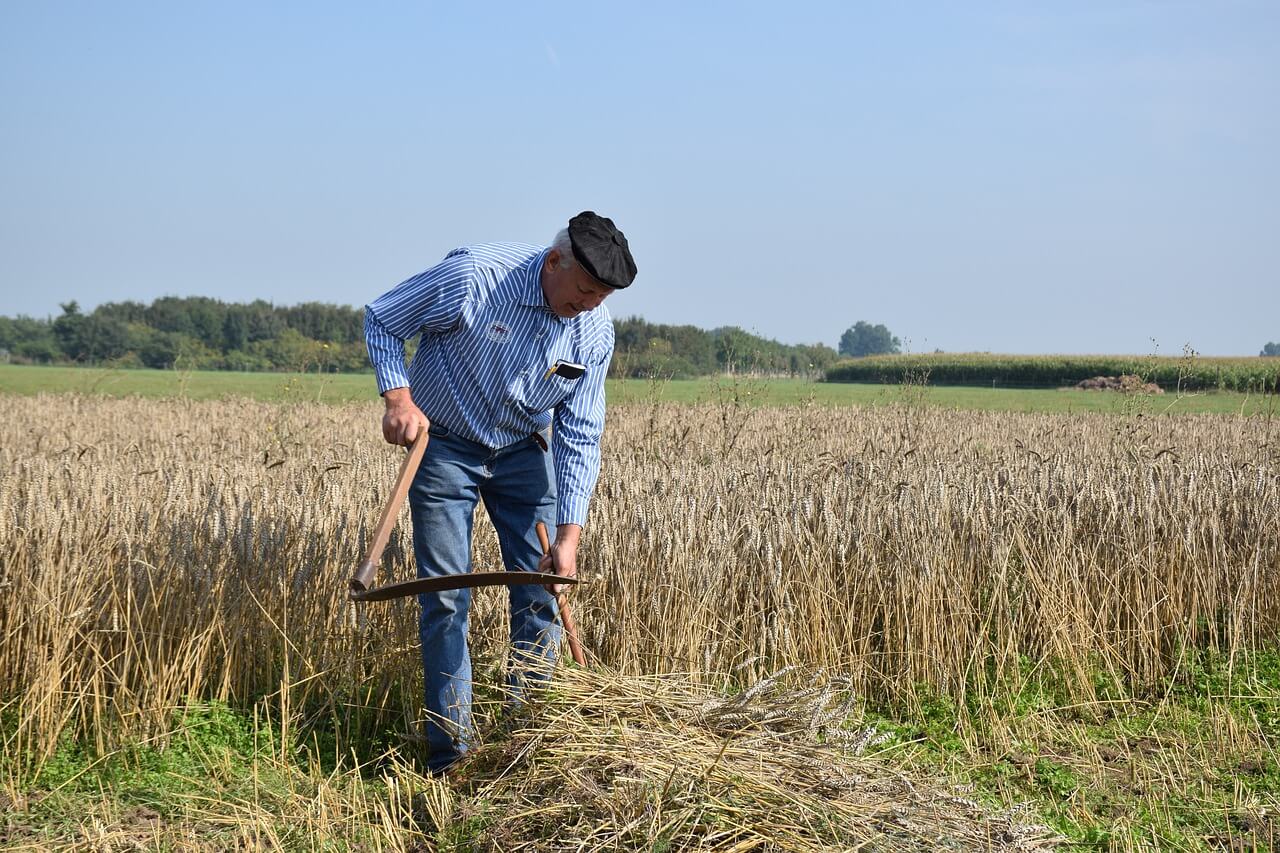The scythe is an essential agricultural hand implement used by people in many parts of the world. It has a slightly curved blade fitted to a long curving shaft, often with two additional handles projecting from it. The origin of the scythe is unknown, but the first records begin in Europe around the 8th century AD. This article will look at how to use and maintain the scythe for use as a helpful hand tool.
What You'll Learn Today
What is a Scythe Used for?

Primarily, scythes are used for cutting grain, crops, and grass. Brush scythes are for cutting back weeds, briar, and branches.
Scythes have been around for centuries, and some were even used as military weapons.
How to use a Scythe to Cut Grass?
The key points to remember before you begin mowing with your scythe are to make sure it’s sharp, that it stays in contact with the ground and that you move gently in an arc.
This video shows how to use a scythe to cut grass:
Here we will discuss using a right-handed scythe, but simply reverse the directions, exchanging right and left if you’re using a left-handed one.
To begin, hold the lower handle in your right hand and the top handle in your left. At the start of each stroke, bring the blade back to your right side, where it is comfortable. The point of the blade should be facing forwards.
Place your weight into your right foot. And use your left arm to pull the scythe and right arm to push, keeping just the tip of the blade slightly raised off the ground.
As you make each stroke, turn at the waist to pivot your body while your arms swing right to left. The blade will naturally follow a semi-circular pattern. As you finish each stroke, the scythe should be facing behind you, and your weight should have transferred from your right foot to your left.
Shuffle forward slightly as you return the blade ready for the next stroke.
Each time you bring the blade back to its starting position, ensure you still maintain a light contact with the ground. You shouldn’t have to lift the entire weight of the blade at any time, as this will tire you far too quickly.
As you move forward, try to avoid walking into your windrow, which is the pile of cut material forming on your left.
Only use enough velocity to make the cut. You don’t need to use vast amounts of force.
Your thighs and buttocks are where the power comes from. Your upper body should guide the scythe without requiring a lot of energy and effort.
It will take a little bit of time and practice to get a feel for using the scythe, but before long, the motion should become apparent and be far more fluid and relatively effortless.
Ensure you take a sharpening stone and water with you and keep the blade sharp, by stopping and giving the blade a quick once over every 5 to 10 minutes.
How to Sharpen a Scythe?
Sharpening a very blunt scythe requires a two-step process. The blade’s edge first requires hammering using an anvil or other smooth hard surface and a hammer to make the edge of the blade as thin as possible. This is called peening.
The art of peening involves repeatedly hitting the edge of the blade in order to thin it and restore its cutting profile. It can also be used to tailor the edge of the blade for the required task.
For example, a thicker blade for cutting weeks or a finer one for lawns. It is also the best way to help eradicate damage that has been caused.
You cannot peen hardened steel blades, as this would require them to be heated.
Once the blade is thin enough, it can then be sharpened or honed using a series of sharpening stones. Start with a coarse stone and work down to a fine one.
When using your scythe, frequent sharpening with a stone while working in the field is required.
Sharpening stones can be made of synthetic or natural materials, and care must be taken not to drop them as they will shatter easily.
Synthetic stones can remove a lot of metal fast and is a good way of achieving a sharp edge quickly. Take care when using a coarse artificial stone that you don’t remove too much metal at once, use light strokes.
Always finish the blade with a fine synthetic stone to achieve a good result.
Natural stones like synthetic ones come in different grades and are best for using while out in the field to re-sharpen your scythe as you work. They don’t remove as much material as synthetic stones but achieve a fine sharp edge.
Sharpening stones are much better when used with water, and the stone needs to be kept continually wet when sharpening your scythe.
As you move the stone over your blade, tiny metal particles and dirt from the scythe’s blade are being removed and must be rinsed away. Failure to do this can cause minute particles to become trapped in the blade making it less efficient at cutting.
If you can’t seem to get your blade as sharp as you’d like, it could be that dirt is lodged in the pores of the metal. To fix this, use a tablespoon of vinegar in a cup of water and take a bar of soap.
Dip the soap into the vinegar water and run along the blade several times. Then take a scrubbing brush or a toothbrush and scrub the blade using the vinegar water. Once you’re finished, give a final rinse with clean water and dry the blade on a lint-free cloth.
Sharpening stones come in various shapes and sizes but will almost always be curved. To use, moisten the stone and stroke it over the surface of the blade, starting at the hilt. Maintain a 20-degree angle between your stone and blade right along to the tip.
It can be a good idea to get your scythe sharpened professionally at the start of every new season. Generally, the charge for this service is relatively small and well worth the investment.
The fastest way of getting a sharp edge is by using a coarse synthetic stone followed by a fine or Dragon stone, but be careful not to remove too much metal with the rough stone. Rozsutec stones give an extra-fine, final edge.
Because sharpening stones break easily, it’s best to keep them in some kind of holder. This keeps them not only safe but also together, making them easier to find when required.
What is the Difference Between a Sickle and a Scythe?

Sickles and scythes are often referred to as being the same tool. Although used for many of the same jobs, they are very distinctly different.
A sickle is a much smaller tool than the scythe and has a smooth or serrated usually curved, blade formed in a semi-circular shape. This is then attached to a short wooden handle approximately the length of your lower arm. In most types of sickle, the blade is in line with the handle.
A scythe is much larger than a sickle. It has a long, slightly curved shaft often fitted with additional handles and a large, tapering, slightly curved blade. The blade itself is set at right angles to the shaft.
Being a far larger tool than the sickle, the scythe can cut much greater areas because the blade is larger.
A sickle is used in one hand in short chopping motions, and the user has to bend down to reach the base of the crop or grass they are cutting. A scythe requires a two-handed operation and involves the entire body moving in an upright position with no need to bend over.
Position of user
- Sickle – Bending over, sitting, or squatting
- Scythe – Standing
Length of handle
- Sickle – Short around the length of the lower arm
- Scythe – Long with additional hand grips
Blade shape and size
- Sickle – Narrow, curved, or hook-shaped blade with or without serrations
- Scythe – Broad tapering blade with a slight curve. Much more significant than a sickle
Direction of use
- Sickle – Can be used in either hand and in both directions, right to left and left to right
- Scythe – Can only be used right to left unless you have a left-handed scythe
Where to Buy a Scythe?
You can find scythes in some garden stores or online at tool retailers, including Amazon or eBay.
It is quite usual for the shaft and blade to be sold as two separate pieces rather than a single unit.
You can purchase both wooden and aluminum shafts, but aluminum ones are very lightweight and long-lasting.
Blades also come in a range of different materials, some to reduce weight and others to lessen the amount of sharpening required.
Conclusion
A scythe can be a handy tool for cutting grass and crops or clearing bothersome weeds from your property.
Because they rely on human power to operate them, you don’t need to worry about buying gas, oil, or cutting wire to use them. The only additional extra required is a good sharpening stone and a little water.
If you’ve found this article about the scythe useful, you may also enjoy reading our other hand tool information. This can be found on our website.